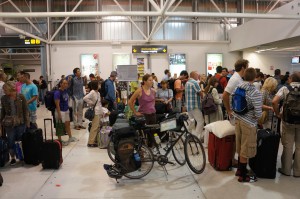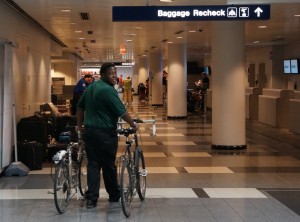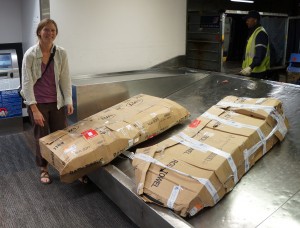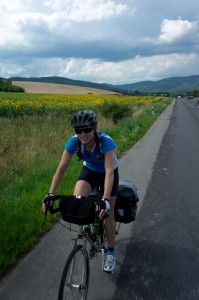 As soon as we escaped the Krakow city limits, I found myself marveling at the fact that I’d ever traveled any other way. Pedaling deeper into the Polish countryside, I could hear snippets of unintelligible conversation mixed with cows mooing, smell grain ripening in the fields that lined the roads, and literally feel the terrain change as we headed towards the border with Slovakia. It was almost alarming how natural it all felt.
As soon as we escaped the Krakow city limits, I found myself marveling at the fact that I’d ever traveled any other way. Pedaling deeper into the Polish countryside, I could hear snippets of unintelligible conversation mixed with cows mooing, smell grain ripening in the fields that lined the roads, and literally feel the terrain change as we headed towards the border with Slovakia. It was almost alarming how natural it all felt.
David had been easing me into bicycle touring (gently or not so gently – you be the judge) for the past year. One of our first dates was a 40-mile ride through wine country in Sonoma. That went well enough – even on the suboptimal bike I was riding at the time – and we took several overnight trips around the Bay Area over the subsequent months, with the longest being a 2-day, 140-mile trip from Davis to Berkeley.
With those journeys together under our belt, we began “planning” a 3-week bike tour through Eastern Europe. I use quotes because in retrospect, the planning was pretty loose: We would arrive in Krakow on July 5 and fly out of Dubrovnik on July 29, and we had a place to stay in Budapest around the 15th. That was pretty much it. We thought it would be about 800 miles of pedaling, and in addition to Budapest, we intended to visit the Tatras mountains, Sarajevo, and the beaches of Croatia (well, I intended to spend some time on the beach; David, as I discovered later, didn’t share that goal). We had ordered some maps and had conversations along the lines of “We could go this way around the mountains,” “Well, this road looks amazing,” and “There are land mines in Bosnia, so we’ll have to be careful about camping.” I don’t know if it was my faith in David’s experience with bike touring, or the fact that much of my travel has involved looking at a map or a guidebook, showing up at a bus station, andand heading into the unknown, but this all felt pretty normal. Later David revealed that he’d been nervous about our minimal level of planning, but he didn’t let it show.
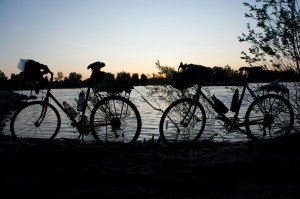 As I discovered, bike touring is in a class of its own, with a unique mix of independence and reliance on strangers different from anything I’d experienced before. Our independence stemmed from our self-propelled mode of travel and the fact that we carried a tent and small stove. This meant that we could, in theory, spend the night anywhere. However, this degree of flexibility also meant we could end up just before sunset in a small town where we’d need help finding water, or, with no obvious public land, we’d need permission to camp in somebody’s yard. Sometimes we just needed help in the form of information about safety, especially in Bosnia where we worried about landmines.
As I discovered, bike touring is in a class of its own, with a unique mix of independence and reliance on strangers different from anything I’d experienced before. Our independence stemmed from our self-propelled mode of travel and the fact that we carried a tent and small stove. This meant that we could, in theory, spend the night anywhere. However, this degree of flexibility also meant we could end up just before sunset in a small town where we’d need help finding water, or, with no obvious public land, we’d need permission to camp in somebody’s yard. Sometimes we just needed help in the form of information about safety, especially in Bosnia where we worried about landmines.
This was hard for me at first. I’ve stayed in plenty of homestays – both formal and informal – and done research projects where I wandered around Mexican towns and the Jamaican countryside interviewing anybody who would take the time to talk to me. But without speaking the language, and being in these countries simply for our own enjoyment, I felt shy about approaching people. The first night, I stayed up on the road while David walked down to speak to a man outside of his house. He pointed at our water bladder and said “voda?” to which the man nodded and gestured towards a spigot outside his house. David then looked around and innocently said “tent, one night?” (our just-learned, and sole, Polish phrase), as if he was asking if there were any place nearby where we could camp. It had the desired effect: within seconds the man and his neighbor were competing with each other to have us camp in their yards. I was impressed with how well this worked and was emboldened to try myself.
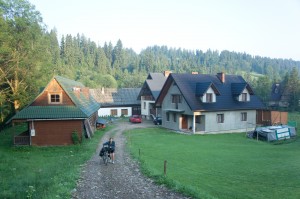 The next time we needed water before setting up camp (it was a rare night when we actually had a destination, in a park several miles down the road), we found ourselves in a town where the only grocery store was closed. I approached a woman in the street and said “voda?” while holding up the water bladder, then pointing sadly at the closed shop. She gestured for me to follow her and led me down the street to her house where I filled the bladder at the sink. From then on, I was much less shy about asking for help, although David was still much better at initiating conversations and accepting help (and food!) from people we met along the way.
The next time we needed water before setting up camp (it was a rare night when we actually had a destination, in a park several miles down the road), we found ourselves in a town where the only grocery store was closed. I approached a woman in the street and said “voda?” while holding up the water bladder, then pointing sadly at the closed shop. She gestured for me to follow her and led me down the street to her house where I filled the bladder at the sink. From then on, I was much less shy about asking for help, although David was still much better at initiating conversations and accepting help (and food!) from people we met along the way.
This style of travel also differed from my previous experiences in how all-consuming it was. Normally, I travel by myself and I’m either working on a project or taking a break from it. I always carry a journal and end up with a lot of quiet time to reflect and write. This time, not only did I have a travel companion (and had left my journal alone to cut precious ounces), but there was never a moment when I had (a) time to myself and (b) energy to write. About half of the time, we stayed with hosts we found through warm showers or couch surfing, and we spent our evenings with them, eating, drinking, and sharing stories of bike touring or learning about growing up under communism. On nights when we camped, despite a fairly efficient routine, as soon as sunset approached we were busy: finding a store to buy dinner and breakfast food, obtaining water, locating a site where we wouldn’t be seen or asking to camp in somebody’s yard, setting up the tent, and fixing and eating dinner. Sometimes we’d read for an hour or two, but given our usual aspirational departure time of 5 or 6, and what I later identified as fairly constant exhaustion, we usually turned in early.
Perhaps the main “down time” was on the bike itself. We’d pedal for hours, often side by side on the quiet roads that David found or that our hosts pointed out, and try to make sense of what we’d seen or read or heard from people we met. On the plane, we started reading Bloodlands, an excellent book about the land between Stalin and Hitler and what its people suffered at their hands, and at the beginning of our trip we visited Auschwitz. As we rode through modern Poland, Slovakia, and Hungary, we tried to wrap our minds around a continent so rich with histories that were still playing out – how the Polish people managed to exist as a unique culture while their territory was torn apart and absorbed into Germany, the USSR, and other neighboring countries. How Poland was “relatively tolerant” of Jews, but how that ultimately meant the mass destruction of a large and thriving Jewish community when Germany invaded during WWII.
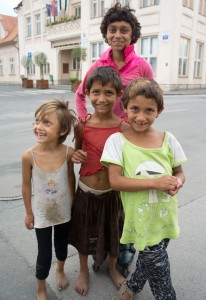 We entered Slovakia in the mountains, and as we descended from them the landscape around us looked like any generic, bucolic European countryside. Then we went through a series of downtrodden industrial towns, with crumbling factories and grim, Soviet-style block apartments. In the rural areas in between, we were puzzled to see darker-skinned children walking down the street or popping in and out of rundown houses. Later, we learned that Slovakia has one of the largest gypsy populations in Europe ; the Slovaks we met weren’t too happy about this, and it was interesting to see our otherwise kind and open-minded Slovak hosts squirm as they explained their distaste for gypsies. David was fascinated and sought out a group of gypsy children in the town we stayed in – they were very friendly and taught me how to count to 10, which turned out to be quite useful later on. Our socializing was cut short, though, when some neighbors arrived home and yelled at the kids, scattering them. Perhaps the most interesting and unsettling part of our trip was Bosnia and Herzegovina. David has some interesting posts on that here and here. As we rode through new landscapes and cultures, trying to absorb the past and reconcile it with the present, we bounced reactions and ideas off of each other, and I found myself not really needing to write in order to process (of course now, months removed from the trip, I wish I’d brought my journal, forced myself to stay up a little later, and written it all down).
We entered Slovakia in the mountains, and as we descended from them the landscape around us looked like any generic, bucolic European countryside. Then we went through a series of downtrodden industrial towns, with crumbling factories and grim, Soviet-style block apartments. In the rural areas in between, we were puzzled to see darker-skinned children walking down the street or popping in and out of rundown houses. Later, we learned that Slovakia has one of the largest gypsy populations in Europe ; the Slovaks we met weren’t too happy about this, and it was interesting to see our otherwise kind and open-minded Slovak hosts squirm as they explained their distaste for gypsies. David was fascinated and sought out a group of gypsy children in the town we stayed in – they were very friendly and taught me how to count to 10, which turned out to be quite useful later on. Our socializing was cut short, though, when some neighbors arrived home and yelled at the kids, scattering them. Perhaps the most interesting and unsettling part of our trip was Bosnia and Herzegovina. David has some interesting posts on that here and here. As we rode through new landscapes and cultures, trying to absorb the past and reconcile it with the present, we bounced reactions and ideas off of each other, and I found myself not really needing to write in order to process (of course now, months removed from the trip, I wish I’d brought my journal, forced myself to stay up a little later, and written it all down).
When we weren’t talking, I found myself slipping into an almost zen-like state. Sometimes when I’m traveling, I’ll daydream, especially on long, uncomfortable bus rides. I do this most when I’m homesick (I remember reconstructing in my mind my favorite meal at my parents’ house in painstaking detail and imagining eating each dish). When I’m engaged in a tough physical activity like running or riding, I often find myself doing calculations – how many miles have I gone, how many are left, what is my pace, how will I reward myself when I hit mile X. On this trip, David had the GPS and I didn’t wear a watch, and the miles just slipped by, largely without any real marking or observation. There were a few long days when, at the end, I’d start counting down the miles left to go (if we even had a destination) in terms of my daily commute to work (“Just ride to work and back 3 times and we’re done!”), but mostly I just spaced out – or, if I want to be generous with myself, I meditated. I fell into the rhythm of my legs rising and falling, of the added effort when we were climbing, the ease of a descent, the colors flying by, the temperature of the air.
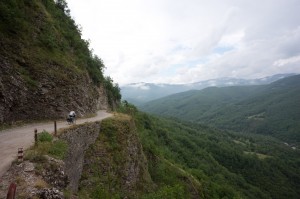 I might say this is my favorite part of bike touring – turning myself into a physical entity, a machine with no purpose other than pedaling, pushing my wheels across miles of pavement (or dirt, or gravel, as the case may be), covering ground, being in the world, on the move, eyes open, taking it all in. But saying that is my favorite part would ignore all of the other elements I loved: the simultaneous ease and challenge of building our trip as we went along – selecting destinations and figuring out routes, finding hosts and making new friends, seeking out hidden corners of countryside to pitch our tent, spending the night in a town (Fil’okovo) where a man we encountered in the street, upon discovering we werere from the US, asked, incredulous, “Fil’okovo? Fil’okovo? But – why?!” It would fail to acknowledge the awesomeness of our descent into the Bay of Kotor down abandoned, car-free switchbacks, the spooky emptiness of the road through destroyed villages in Bosnia, the unexpected connection with the family roasting a goat on the side of the road who pushed shots of brandy on us in the middle of the day, the joy of getting to know your partner better by discovering something new together. Fortunately, though, I don’t have to pick a favorite part – instead, I’m picking a destination for our next trip.
I might say this is my favorite part of bike touring – turning myself into a physical entity, a machine with no purpose other than pedaling, pushing my wheels across miles of pavement (or dirt, or gravel, as the case may be), covering ground, being in the world, on the move, eyes open, taking it all in. But saying that is my favorite part would ignore all of the other elements I loved: the simultaneous ease and challenge of building our trip as we went along – selecting destinations and figuring out routes, finding hosts and making new friends, seeking out hidden corners of countryside to pitch our tent, spending the night in a town (Fil’okovo) where a man we encountered in the street, upon discovering we werere from the US, asked, incredulous, “Fil’okovo? Fil’okovo? But – why?!” It would fail to acknowledge the awesomeness of our descent into the Bay of Kotor down abandoned, car-free switchbacks, the spooky emptiness of the road through destroyed villages in Bosnia, the unexpected connection with the family roasting a goat on the side of the road who pushed shots of brandy on us in the middle of the day, the joy of getting to know your partner better by discovering something new together. Fortunately, though, I don’t have to pick a favorite part – instead, I’m picking a destination for our next trip.













